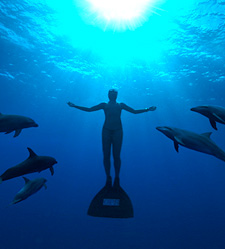 Where does your dolphin come from?
Where does your dolphin come from?
I'm not suggesting you have a personal 'Flipper' in the backyard pool; I mean the one that's in your local zoo or aquarium. How did it come to be in that tank?
For some reason I just assumed that my local marine mammals were the beneficiaries of some benevolent back-story. You know: a baby dolphin, separated from its mother and caught in fishing nets, is rescued by marine biologists and nursed back to health in a nice, safe swimming pool where it simultaneously develops a love for its rescuers and a playful desire to do tricks. And sure, that might be where your dolphin did come from - but it can't be the origin for every performing porpoise on the planet, right?
Enter the makers of The Cove. Before watching this film I had never even heard of the term 'dolphin slavery'. Now I'm wondering how I ever managed to think it could work any other way. This documentary is likely to sow the ground broken by that other environmental think-piece, An Inconvenient Truth. If it gains anywhere near the same amount of exposure then Christians should be aware of the significant impact it is likely to have on Gen Y - a generation that is rediscovering communities built on common causes.
The Cove revolves around the revelations of environmental activist Richard O'Barry. In the 1960's O'Barry introduced the world to Flipper, capturing and training all five dolphins used in the series. However his 'road to Damascus' moment came when he watched the last one die in captivity. O'Barry realized he had been instrumental in helping create a multi-billion dollar industry of aquariums and swim-with-dolphin parks that required captured dolphins to survive. "I spent 10 years building that industry up and the last 35 years trying to tear it down."
The Cove purports to reveal how that industry feeds its need for friendly dolphins. On the coast of Japan is a village called Taiji where each September the local fishermen heard up to 23,000 dolphins and porpoises into a highly protected cove. The lucky ones are selected by international aquarium buyers who will pay up $150,000 US for a good performer. Those who don't make the cut face the chop. In what can only be described as some of the most distressing footage since the world first witnessed the clubbing of baby seals, the left-over dolphins are systematically stabbed until the cove's waters literally turn red.
The Cove is unashamedly partisan and emotive in its use of vision and story-telling technique. The plot is borrowed from an episode of Mission Impossible. The documentary makers have to assemble an Oceans 11 team of diving and surveillance experts to circumvent obstructionist Japanese officials. However their covert operation eventually results in them succeeding in filming the slaughter with military-grade infrared lenses and cameras disguised as rocks. Intercut with this vision are empowering, calendar-quality pictures of dolphins in the wild, and human beings interacting with them on the mammal's terms. If there is a fault it's that documentary tries to cover too much ground, moving back and forth from Taiji's secret to Japanese whaling policies, the increasing amount of mercury in dolphin meat, and the resultant birth deformities in humans. Despite the impact being spread over various fronts, though, the message remains clear: people impacted by the dolphin's plight have a responsibility to act. As director Louie Psihoyos puts it:
"To me you’re either an activist or an inactivist. I wanted to be an activist and help stop this."
There is a zealous approach to environmentalism here that borders on an alternative religion. The dolphins are frequently raised to near human status and beyond. Discussing the training of captured dolphins O'Barry says, "They are always trying to communicate with us . We have something to teach them [but] maybe we should be listening to them." Clearly the makers would not accept the biblical viewpoint that dolphins form part of the world's resources that humans are responsible for wisely steward. But it is possible for Christians to get behind their conclusion without arriving there by the same path. It's also worthwhile learning what the filmmakers understand about modern audiences.
The Cove zeros in on the current generation's emerging activism and its desire to make a difference. Environmental causes seems to be a focal point for Gen Y in much the same way as the nuclear threat was for Gen X and the Vietnam War for the Baby Boomers. However today's youth seems increasingly attracted to communities that can clearly enunciate their goals and aim to make a difference. The whole burden of The Cove rests in the end on stopping the slaughter at Taiji. "If we can’t stop that," says O'Barry, "Well, forget about the bigger issues." The focal point is small and above all achievable. The film ends with the warning:
TheTaiji dolphin slaughter is set to resume every September - unless we stop it.
The question is, can modern Christianity rise to the challenge represented by The Cove's message? Generation Y has gotten over the ennui experienced by Generation X. Its members know that they can't save the world in a day or even a year but they are looking for a place to begin. The Christian message is still hampered on many fronts by attendant requirements - a fully redeemed lifestyle, regular attendance of a good church, daily Bible studies. However repentance and conversion do not depend on these things. In fact in many cases our morality, missional and theological debates actually detract from the message. Are younger people attracted to alternative causes, even churches, because of they offer a simple message and a clear point to start?

















